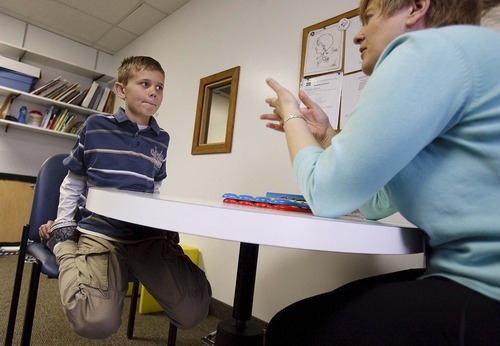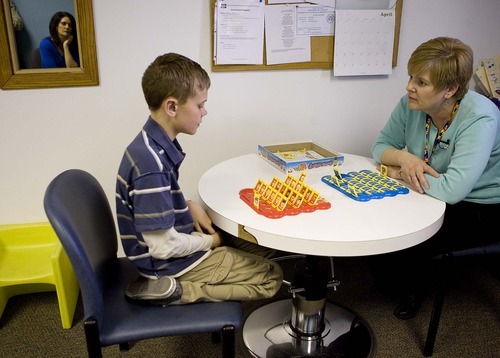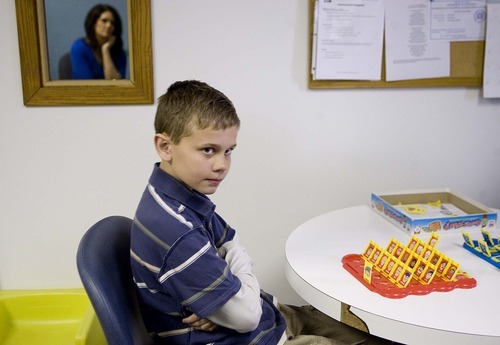This is an archived article that was published on sltrib.com in 2011, and information in the article may be outdated. It is provided only for personal research purposes and may not be reprinted.
Jen Jorgenson knows it's scary for parents to have a child diagnosed as autistic. Fear kept her from seeking help, even though her son wasn't talking or eating anything but baby food until age 3.
With her second son, the Draper mother was looking for the telltale signs, and Benjamin was diagnosed a year earlier than his brother. She believes the extra year of therapy Benjamin will receive will make a "huge difference" in his life.
"It's a scary thing to know that your child is autistic and he's different — and that's how he's going to be for the rest of his life," she said Friday. But "the best thing for them is to find out soon, the sooner the better, and help them."
That's the approach more Utah pediatricians are taking: An initiative funded by the Utah Department of Health has encouraged about 30 physicians' offices to screen all their pediatric patients at age 18 months and again at 24 months for autism. Some pediatricians may be screening patients on their own.
It's a practice the American Academy of Pediatrics (AAP) recommended in 2007. The average age of diagnosis is between 4 and 5, but the ideal is age 2.
"We would really like to make the diagnosis earlier, so we would at least have a chance of getting those kids intensive therapy," says pediatrician Paul Carbone, who cares for autistic children at a University of Utah clinic and helped the AAP devise its recommendations. "Kids that learn certain skills at early ages have a better prognosis to become independent adults."
He has led the three-year effort to make the screening easier for doctors through the Utah Pediatric Partnership to Improve Healthcare Quality. Under the initiative, the number of toddlers screened jumped from about 28 percent to 94 percent in participating clinics.
Parents are given a 23-question survey, called "The Modified Checklist for Autism in Toddlers," or M-CHAT. If the parent fails two or more critical questions — the child doesn't take an interest in other children and doesn't point to indicate interest in something, for example — the youngster is considered "at risk." He or she would be referred to a clinic that can diagnosis autism.
At-risk children are also referred to an audiologist, in case they fail the screening because of a hearing problem. And they are referred to early intervention specialists offered through the Utah Department of Health or local school districts.
"Even if they don't end up having autism, chances are they have something like a developmental or a language problem," Carbone said.
Youngsters are screened twice because 25 percent of children with autism will be developmentally on track at 18 months but will regress in language or social skills by age 2, he said.
Jorgenson asked for her second son to be screened when he was a year old because she was already familiar with autism.
But many parents may not be as attuned to the social-skills milestones their children should reach — such as imitation or pretend play — as they are for physical ones such as walking. That's why all children should be screened — not just those whose parents are worried, Carbone said.
If their children aren't being screened, parents may want to ask their pediatricians to do so, he said, noting that when he worked as a general pediatrician, he identified children with autism whose parents weren't concerned.
"If the diagnosis is truly autism, it won't go away," he said.
Joining the screening initiative not only helped Intermountain Healthcare's Sandy clinic identify patients with autism and other developmental disabilities, but it changed how it cares for those children, said registered nurse Kathy Heffron, the clinic's pediatric case manager.
Parents are able to check into the clinic from the parking lot and wait until a room is available. That way, children can avoid the waiting room, which may be too stimulating. The clinic also offers a "what to expect" program for parents.
"We just do it [the screening] as a matter of fact, just like immunizations," Heffron said.
But as pediatricians increase screening, the demand for limited diagnostic services and therapy is growing. Carbone said children referred for diagnosis to the Health Department's Child Development Clinic have to wait two to four months. And the number of Utah providers for what is considered the best therapy for autism — 20 hours a week of applied behavioral analysis — also have waiting lists.
Still, parents of autistic children say other therapy that's more easily accessible helps.
Amanda Patten, of South Jordan, sends her 10-year-old son, Mason, to a speech therapist at a Primary Children's Medical Center rehabilitation clinic, where he is working on making the "th" sound and understanding idioms.
"If somebody says, 'Go jump off a bridge,' what does that really mean? These kids take everything so literally," she said.
The years of speech and occupational therapy — Mason was diagnosed at age 2 — have made a difference. His temper tantrums have ceased, he initiates conversations and makes eye contact, Patten said.
"He'll just come up to me randomly and give me a hug and say, 'I love you, Mom,' " Patten said. "He never even said 'mom' before he was 4. He's absolutely a different kid."









